|
Walking through a lush and colourful
back garden, I recently came upon a
wonderland in miniature, offering
visitors a nostalgic and vivid insight into the
bygone Age of Steam.
This virtual secret garden experience is to be enjoyed on a
trip to the home of model railway expert John Webster of
Oakfield Close, Kempsey.
Hidden away amid trees, shrubs and arrays of flowers at
the bottom of his magnificent back garden is to be found a
very large shed packed with the fruits of his 30 years as a
railway modeller.
There's a layout of Pershore Station in times past, a large-
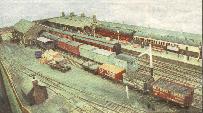
scale and dramatic depiction of a piece of local railway
history that never came to pass - a substantial train terminal
at Diglis Dock - and, as an addition to more recent times, a
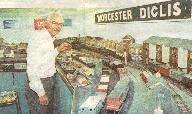
line of railway wagons bearing the names of Worcester's coal
merchants of a century or so ago.
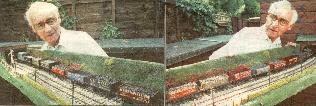
And it is with this latest project that John Webster is
anxious to enlist the help of Memory Lane readers.
His line-up of Worcester wagons is unique and already
represents the nation's largest collection in model form of
privately-owned coal wagons which operated out of just one
town or city, during the heyday of steam.
In recent years, he has painstakingly reconstructed in
miniature 14 wagons which once proudly bore the names of
Worcester coal merchants on England's Victorian and Edwardian
railways.
It has meant considerable research in order to re-create the
wagons in complete and authentic detail.
In a few instances, John has been able to consult old
photographs and has managed, in several others, to trace
original designs and precise dimensions from plans still
surviving in the archives of former railway rolling stock
construction firms.
He has also received the help and advice of former railmen
and people with memories of the coal merchant firms of
times past.
A few months ago, John put his collection of coal wagons on
public display for the first time at the National Model
Railway Exhibition at the NEC - and was in for a big
surprise!
"A chap with a Canadian accent came up to me and said
there was at least one wagon missing from the line-up. His
grandfather had been a coal merchant at Worcester and had
owned railway wagons.
"Thus it was that my collection now has another wagon
bearing the name 'A.B Wyatt, Coal Merchant, Belmont
Street, Rainbow Hill.'
"It is all thanks to that descendant, who was born and
brought up in Worcester, but emigrated to Ontario, Canada,
after the last war," explains John, who would dearly like to
hear from Memory Lane readers who can supply photographs
or details of any other Worcester area firms who owned or
operated rail wagons during the days of steam.
They need not have been coal merchants but simple
companies involved in the transport of goods.
He will try to make models of such wagons in time for a
special public display he is planning mount in October, as
part of the celebrations to mark the 150th anniversary of the
opening of Shrub Hill station.
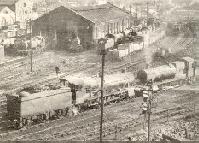
> Readers can either ring John Webster on 01905 820848
or send in their information to me at the Evening News.
The line-up of wagons John has so far created carry the names
Underwood and Co; Worcester Gas Works; the South
Wales and Cannock Chase Coal and Coke Society Ltd; Worcester
New Co-operative Society Ltd; John Allbutt and Co. of
Stanley Road; William Hudson; William Barnard; James
Probert of the Arboretum, Herbert Preston of Lowesmoor; R.
Dayus of Little Park Street' A.B Wyatt; Henry Hunting of
Bowling Green Terrace; Herbert Partridge of St Nicholas
Street and a firm which simply put the initials "J.G" on its
wagons.
In fact, John would very much like to know if anyone can
identify this particular coal merchant's firm. I have
Worcester directories for the years 1840 and 1910 and can
suggest two outside possibilities - the firms J. Godwin of
Sidbury, or John Greenway of Foundry Street.
Another question John would very much like answered is
whether Hill, Evans & Co, of the Vinegar Works in
Lowesmoor, ever had wagons bearing its name on the branch
line that operated between their site and Shrub Hill.
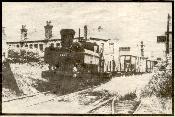
He wonders too whether famous Worcestershire Sauce
makes Lea & Perrins had railway wagons bearing their own
distinctive company orange and black logo?
His display, in October, will not only feature his coal
wagons line up but also models of steam locos and other
rolling stock which operated out of Shrub Hill station in the
heydays of steam.
For about 30 years, John Webster ran his own business in
the heart of Worcester - the Handyman Centre in Charles
Street - and it was out of this enterprise that was born his
own enduring passion for making model railways.
He has now been engrossed in this time-consuming pastime
for about three decades and was long-time chairman of the
former Worcester Model Railway Club. He staged several
big model railway shows in aid of charity at the
Barneshall Indoor Bowling Centre.
Until two years ago, he and wife Janet lived in
Battenhall Road, where he also had a 40ft long shed
packed with his model railway layouts. It was there
that I last met John in the summer of 1993, when he
showed me the completion of his major venture of
the time - the creation in miniature of a projected
Diglis Dock rail terminal which never materialised.
His researches over previous years had led him to
the City Museum basements in Forgate Street, and
to the discovery of plans produced in the late 1880s for a
railway branch line from Spetchley to Diglis Dock.
It was the brainchild of the strangely named East
and West Midland Junction Railway Company
which proposed to lay its branch line across the
Timberdine Meadows, under the Bath Road by tunnel
in the Cherry Orchard area, and across the Diglis
Fields to the dock.
A sizeable rail terminal with a station and sidings
would have been built close to significant freight
generating locations such as the extensive Royal
Worcester Porcelain factory, timber yards and the
meeting point of the River Severn and the
Worcester-
Birmingham
Canal.
This
terminal
would
have
given
easy
access
for
goods to main rail routes nationwide, but
the scheme was eventually abandoned as
the promoters could not raise the
necessary capital and because of
intense opposition from the Berkeley family of
Spetchley Park, across whose estate the
branch line would have been carved.
Nevertheless, the prospect was revived by
the LMS company in the early 1920s, but
again it came to naught.
However, by his elaborate layout to the
original plans, John provides a striking
impression of what might have been. We
can see the Diglis Dock station, sidings,
locos and rolling stock, the canal and
barges, the porcelain factory, and a range
of dockland buildings and warehouses which might will have
sprung up, very much along the lines of those still to be seen
at Gloucester Docks.
A key feature of the layout is the lock keeper's cottage - an
actual and surviving building at Diglis.

John says it's "amazing" just how many people are
fascinated by model railways, especially ex-railwaymen. He
has always received great help and valuable information
from them and also from local historians including
Bill Gwilliam and friend Ted Edwards of Hatfield who has also
been featured in Memory Lane.
"Model railways help re-create a bygone age which is all
history now," stresses John.
Even so, his creative talents nowadays are not just confined
to this pastime. He and his wife have become keen gardeners
and, in just two years, have produced a superb back garden
layout - life-size and certainly not in miniature!
It is about to be opened up to the public of next weekend's
Kempsey Walkabout in aid of local church funds. John is
currently chairman of the Norton Gardening Club.
Click here for the follow up story of the "absolutely brilliant" response John got to this article.
Related pages:
|

 hits since 26th September 2000.
hits since 26th September 2000.



